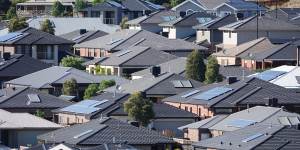Every day it’s a different coloured ribbon and another event where politicians dutifully listen to the latest political woe,grab some freebies and a photo for social media before moving on to the next problem.

After nine years in office,the Andrews’ government is only now preparing to unveil its housing package.Andrew Dyson
With so many problems to fix,what is the magical formula that zaps a government into acting on a particular issue?
A few weeks ago,I was invited to speak at a forum alongside Victoria’s former deputy premier John Thwaites,who tried to tackle this very question. Thwaites,who was a cabinet minister for eight years,explained that three crucial ingredients must exist for meaningful policy change:a clearly defined problem,a feasible solution,and – most importantly – the political will to do it.
Perhaps this goes some way to explaining why – after nine years in office – the Andrews’ government is only now preparing to unveil its housing package,with the aim of addressing affordability,containing urban sprawl and tackling rising rents.
None of these issues are new,of course. Ironically,it was Thwaites who was the planning minister when Labor last tried to tackle this problem. That was 22 years ago.
With its Melbourne 2030 strategy,the government pushed for a more compact city based around transport hubs,but the plan ultimately unravelled following backlash from traditional Labor strongholds of inner-Melbourne.
Since then,the need to contain urban sprawl has only intensified. Melbourne is in the world. If you look at it on a map,Melbourne occupies more land than London,which has almost double our population,or Mexico City,which houses more than 20 million people.
According to Infrastructure Victoria,Melbourne will need to meet projections that the city’s population will grow to more than 8 million over the next 30 years.
But the current model of sticking new houses on the outskirts of our city is creating more headaches for the government as the population continues to grow because as Infrastructure Victoria says,building new roads,schools and transport hubs on the city’s fringes can be up to four times more expensive than transforming existing infrastructure in established suburbs.
While the political problem hasn't changed,why is it that the government is now willing to act?
Putting to one side the fact Daniel Andrews has just been reelected for a third term – and with a thumping majority – there has been a significant shift in the voting demographic across the state in the past two decades.
Next time Victorians go to the polls,almost half of the state’s voters will be Millennials and Gen Z,who are at the forefront of housing shortages and skyrocketing rental prices. Many are also more eager to live closer to the city.
So with a clearly defined problem and a more accepting electorate,what is the solution?

Melbourne is one of the largest and least densely settled cities in the world.Paul Rovere
Most housing experts – including many who have advised the government on its latest reforms – argue that simply asking councils to double or triple the number of homes in their municipalities won’t be enough without incentives,like tax breaks or funding boosts for local governments willing to fast-track planning approvals,in place.
A more forceful approach could see the government tackle restrictive zoning regulations to permit more low-rise apartments and higher-density living. This approach has merit. In 2016,75 per cent of residential land in the New Zealand city of Auckland was rezoned,tripling the city’s dwelling capacity in the process.
And it’s the middle ring suburbs along Labor’s flagship like as Glen Waverley,Cheltenham,Sunshine and Reservoir where the government really needs to tackle supply.
While the risks of a higher-density planning policy has dissipated in the past two decades,such a pursuit could still leave Labor vulnerable to backlash from.
This quandary also presents the Coalition with a difficult decision. To appeal to younger voters – voters it desperately needs – the opposition must resist the temptation to campaign against development in low-density residential suburbs.
As rumours of Andrews’ impending retirement from politics continue unabated,his apparent departure – whenever it comes – prompts questions of his legacy.
A social reformer,political colossus and transport transformer who built much-needed roads,bridges,tunnels and oversaw the level crossing removal program? Or an economic saboteur who left the state penniless and implemented stringent and divisive lockdown measures?
As he nears the end of his tenure,housing planning policy remains the missing piece of the legacy puzzle,and one that will help decide if Melbourne’s tradition of being a great place to live and work continued under the stewardship of Andrews.
Annika Smethurst is state political editor.
The Opinion newsletter is a weekly wrap of views that will challenge,champion and inform your own.Sign up.